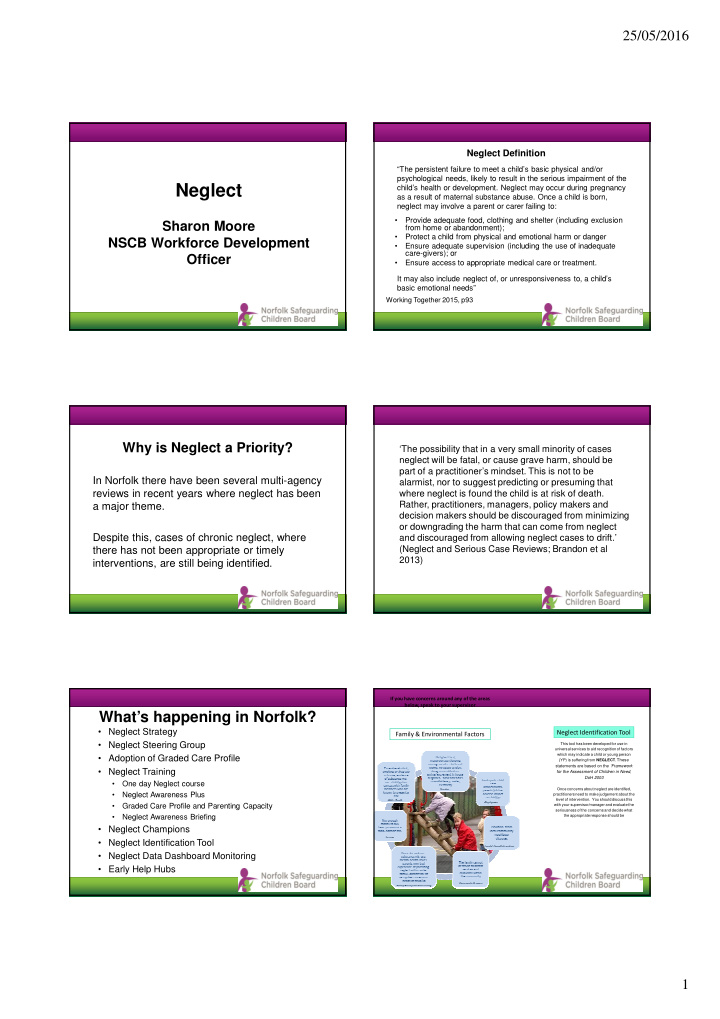



25/05/2016 Neglect Definition “The persistent failure to meet a child’s basic physical and/or psychological needs, likely to result in the serious impairment of the Neglect child’s health or development. Neglect may occur during pregnancy as a result of maternal substance abuse. Once a child is born, neglect may involve a parent or carer failing to: • Provide adequate food, clothing and shelter (including exclusion Sharon Moore from home or abandonment); • Protect a child from physical and emotional harm or danger NSCB Workforce Development • Ensure adequate supervision (including the use of inadequate care-givers); or Officer • Ensure access to appropriate medical care or treatment. It may also include neglect of, or unresponsiveness to, a child’s basic emotional needs” Working Together 2015, p93 Why is Neglect a Priority? ‘The possibility that in a very small minority of cases neglect will be fatal, or cause grave harm, should be part of a practitioner’s mindset. This is not to be In Norfolk there have been several multi-agency alarmist, nor to suggest predicting or presuming that reviews in recent years where neglect has been where neglect is found the child is at risk of death. Rather, practitioners, managers, policy makers and a major theme. decision makers should be discouraged from minimizing or downgrading the harm that can come from neglect Despite this, cases of chronic neglect, where and discouraged from allowing neglect cases to drift.’ (Neglect and Serious Case Reviews; Brandon et al there has not been appropriate or timely 2013) interventions, are still being identified. If you have concerns around any of the areas below, speak to your supervisor What’s happening in Norfolk? • Neglect Strategy Neglect Identification Tool Family & Environmental Factors • Neglect Steering Group This tool has been developed for use in universal services to aid recognition of factors which may indicate a child or young person • Adoption of Graded Care Profile (YP) is suffering from NEGLECT . These statements are based on the ‘Framework • Neglect Training for the Assessment of Children in Need, DoH 2000 • One day Neglect course Once concerns about neglect are identified, • Neglect Awareness Plus practitioners need to make judgement about the level of intervention. You should discuss this • Graded Care Profile and Parenting Capacity with your supervisor/manager and evaluate the seriousness of the concerns and decide what • Neglect Awareness Briefing the appropriate response should be • Neglect Champions • Neglect Identification Tool • Neglect Data Dashboard Monitoring • Early Help Hubs 1
25/05/2016 If you have concerns around any of the areas below, speak to your supervisor The Assessment of Neglect Graded Care Profile Based on an approach by Drs Polnay and Shrivastava Where a child/young person as a disability the additional factors below may be indicators of neglect: • Not getting enough help with feeding • Poor toileting arrangements • Lack of stimulation • Unjustified and/or excessive use of restraint • Rough handling, extreme behaviour modification e.g. deprivation of liquid, medication, food or clothing • Unwillingness to try to learn a child’s means of communication • Ill-fitting equipment e.g. calipers, sleep boards, inappropriate splinting Graded Care Profile • A single and multi-agency assessment tool for situations where neglect is known or suspected • An objective measure of care across all areas of need • Does not diagnose neglect but rather highlights strengths and weaknesses • Provides a unique reference point against which to measure the impact of interventions • Is completed with the parents/carers as part of an open honest conversation It is a descriptive scale. The grades indicate It can be used to improve understanding about quality of care and are recorded using the same the level of concern and to target areas for work 1-5 scale in all areas. Instead of giving a as it highlights areas of greater risk of poorer diagnosis of neglect it defines the care showing outcomes. It should be used in all cases where both strengths and weaknesses as the case neglect is identified as an issue. The profile can may be. It provides a unique reference point. be used with the family by individual workers, or Changes after intervention can demonstrably be groups of workers, to inform Family Support monitored in both positive and negative meetings, Children in Need meetings and Child directions. Protection meetings. 2
25/05/2016 The Graded Care Profile How does the Graded Care Profile fit with Signs of Safety? (GCP) • Both are child focused • GCP should be completed with parents • Child focussed • GCP can be used to evidence • Enables level of neglect and progress to be • What is working well as well measured and evidenced • What are we worried about • Evaluates strengths as well as weaknesses • What needs to happen • Involves the family in partnership • Provides a snapshot of a period of time that can • Allows help to be targeted where needed be used to evidence change • Cross cultural Thank you 3
Recommend
More recommend